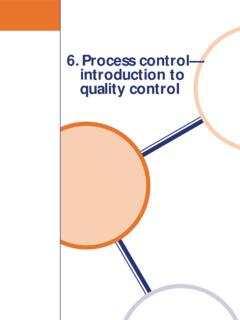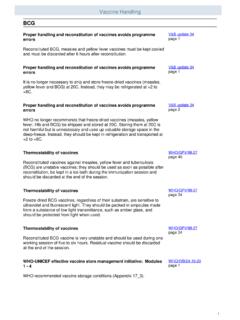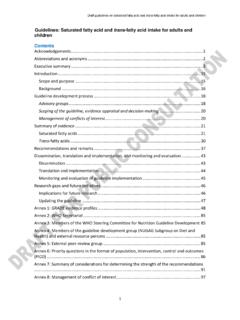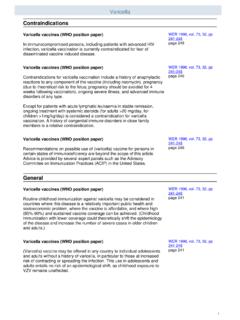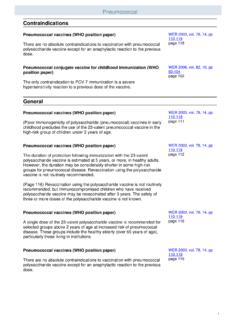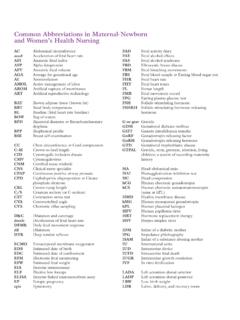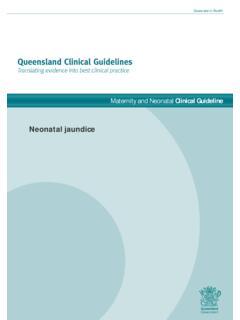Transcription of Strategic Plan for Maternal, Newborn, Child and Women’s ...
1 Strategic plan for maternal , newborn , Child and women s Health (MNCWH) and Nutrition in South Africa 2012 - 2016 2 CONTENTS List of abbreviations SECTION A: INTRODUCTION .. 6 MNCWH service delivery .. 8 Priority Health Interventions for reducing maternal and Child Mortality: Service Package 9 SECTION B: PRIORITY INTERVENTIONS FOR maternal HEALTH .. 11 1. Basic Antenatal Care .. 12 2. HIV testing and access to ART .. 13 3. Improved access to care during labour .. 13 4. Intrapartum Care .. 13 5. Post-natal care within six days of delivery .. 14 SECTION C: PRIORITY INTERVENTIONS FOR newborn HEALTH .. 15 1. Promotion of early and exclusive breastfeeding .. 17 2.
2 Resuscitation of newborns and care for small/ill newborns according to standardized protocols .. 18 3. Kangaroo Mother Care (KMC) .. 18 4. Post-natal visit within six days .. 18 SECTION D: PRIORITY INTERVENTIONS FOR Child HEALTH .. 19 1. Promotion of breastfeeding and appropriate complementary feeding practices for infants and young children .. 20 2. Preventative services .. 20 3. Correct management of common childhood illnesses using the IMCI case management process .. 22 4. Management of ill children in hospitals .. 23 5. Early identification of HIV-infected children and appropriate management .. 24 6. Long term health conditions in children .. 24 7. Improving provision of School Health Services.
3 25 SECTION E: PRIORITY INTERVENTIONS FOR women S HEALTH .. 26 1. Access to contraceptive services .. 26 2. Improved reproductive health services for adolescents .. 26 3. Cervical cancer screening .. 27 4. Gender-based violence and post-rape services .. 27 SECTION F: PRIORITY INTERVENTIONS: COMMUNITY-BASED MCH SERVICES .. 28 1. Provision of a package of MCH services by ward-based PHC outreach teams .. 28 2. Multi-sectoral action to reduce poverty and inequity .. 28 3. Development of a MNCWH communication strategy .. 28 SECTION G: MNCWH & NUTRITION Strategic plan .. 29 1. Vision .. 29 2. Mission .. 29 3. Guiding Principles .. 29 4. Overall Goal .. 29 3 SECTION H: KEY STRATEGIES FOR IMPLEMENTATION OF PRIORITY INTERVENTIONS.
4 30 SECTION I: MONITORING AND EVALUATION FRAMEWORK .. 44 SECTION J: CRITICAL SUCCESS FACTORS .. 45 4 ABBREVIATIONS ANC Antenatal Care APP Annual Performance plan ART Antiretroviral therapy ARV Antiretrovirals BANC Basic Antenatal Care CARMMA Campaign for the Accelerated Reduction of maternal Mortality in Africa CCMT Comprehensive Care, Management and Treatment CBO Community Based Organization Child PIP Child Healthcare Problem Identification Programme CHW Community Health Workers CLO Community Liaison Officer CoMMiC Committee on Mortality and Morbidity in Children CTOP Choice on Termination of Pregnancy DBE Department of Basic Education DOH Department of Health DHIS District Health Information System ECD Early Childhood Development EDL Essential Drugs List EMOC Emergency Management of Obstetric Care EMS Emergency Medical Services EPI Expanded Programme on Immunisation HDACC Health Data Advisory and Co-ordination Committee HHCC Household and Community Component (of)
5 IMCI) HPV Human Papilloma Virus HSRC Human Sciences Research Council ISHP Integrated School Health Programme IDP Integrated Development plan IMCI Integrated Management of Childhood Illness KMC Kangaroo Mother Care KPA Key Performance Area LBW Low Birth Weight MBFHI Mother and Baby Friendly Hospital Initiative MDG Millennium Development Goal MMR maternal Mortality Ratio MNCWH maternal , newborn , Child and women s Health MRC Medical Research Council MTS Modernization of Tertiary Services NaPeMMCo National Perinatal Mortality and Morbidity Committee NBTS National Blood Transfusion Service NCCEMD National Committee on Confidential Enquiries into maternal Deaths NDOH National Department of Health NFCS National Food Consumption Study NSDA Negotiated Service Delivery Agreement NSP National Strategic plan (on HIV, STIs and TB) PCR Polymerase Chain Reaction PHC Primary Health Care PMTCT Prevention of Mother to Child Transmission (of HIV infection) PPIP Perinatal Problem Identification Programme RED (strategy) Reach Every District (strategy)
6 SADHS South African Demographic and Health Survey 5 SAPS South African Police Service SAQA South African Qualifications Authority SASO Specified Auxiliary Service Officer Stats-SA Statistics South Africa STI Sexually Transmitted Infection TB Tuberculosis UNICEF United Nations Children s Fund WHO World Health Organization YFS Youth Friendly Services 6 SECTION A: INTRODUCTION South Africa is committed to reducing mortality and morbidity amongst mothers and children. This commitment is reflected in the Negotiated Service Delivery Agreement (NSDA) which was signed in 2010 and which identifies reductions in maternal and Child mortality (as well as in the prevalence of TB and HIV) as key Strategic outcomes for the South African health sector.
7 South Africa also remains committed to working towards achievement of the Millennium Development Goals (MDGs). Although achievement of all the MDGs has important implications for the health and well-being of women , mothers and children, MDGs 1, 3, 4, 5 and 6 are of particular importance (see box below). Delivery of comprehensive quality MNCWH services is dependent on a well-functioning health system. Interventions outlined in the strategy are therefore closely linked to and aligned with efforts to strengthen the health system and especially to improve the functioning of PHC services and the district health system. Interventions contained in this plan reflect and support the process of PHC re-engineering.
8 The three strands of PHC re-engineering, namely establishment of ward-based PHC outreach teams, expansion and strengthening of School Health services and establishment of district clinical specialist teams, will all contribute to improving maternal and Child health. The ward-based PHC outreach teams will play a key role in delivering community-based MNCWH services to communities and household level, and will facilitate access to services at PHC and hospital levels. Strengthening of school health services will contribute towards improved health and learning outcomes for children and youth, whilst the district clinical specialist teams, which will be made up of an obstetrician, a paediatrician, a family physician, an anaesthetist, an advanced midwife, an advanced paediatric nurse and a PHC nurse, will play a key role in ensuring provision of quality MNCWH services at all levels within the district, with a particular focus on ensuring supervision and support of MNCWH services at PHC and district hospital levels.
9 HEALTH-RELATED MILLENNIUM DEVELOPMENT GOALS 1. Eradicate extreme poverty and hunger Halve, between 1990 and 2015, the proportion of people whose income is less than one dollar a day. Achieve full and productive employment and decent work for all, including women and young people. Halve, between 1990 and 2015, the proportion of people who suffer from hunger. 3. Promote gender equality and empower women Eliminate gender disparity in primary and secondary education preferably by 2005, and at all levels by 2015. 4. Reduce Child mortality Reduce by two-thirds, between 1990 and 2015, the under-five mortality rate. 5. Improve maternal health Reduce by three quarters, between 1990 and 2015, the maternal mortality ratio.
10 Achieve, by 2015, universal access to reproductive health. 7 6. Combat HIV/AIDS, malaria, and other diseases Have halted by 2015 and begun to reverse the spread of HIV/AIDS. Achieve, by 2010, universal access to treatment for HIV/AIDS for all those who need it. Have halted by 2015 and begun to reverse the incidence of malaria and other major diseases. The recently released report of the Health Data Advisory and Co-ordination Committee (HDACC) Report (2011)1 recommends the following baselines (2009 data) and targets for 2014: Indicator Baseline (2009)1 Target (2014)1 Target (2016) maternal Mortality Ratio (per 100 000 live births) 310 270 Under 5 mortality rate (per 1 000 live births) 56 50 40 Infant mortality rate (per 1 000 live births) 40 36 32 Neonatal mortality rate (per 1 000 live births) 14 12 11 Table 1: Mortality rates: baselines and targets The HDACC considered that a 10% reduction in mortality for each of these rates was feasible by 2014 (these are shown in Table 1).

